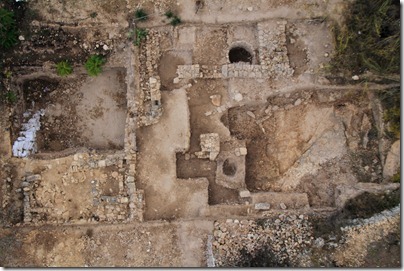A Judean temple from the 10th-9th centuries BC has been discovered four miles northwest of ancient Jerusalem. The structure has massive walls, faces east, and contained a cache of sacred vessels. The site of Tel Motza may be the town of Mozah mentioned in the city list of Joshua 18:26 and some believe the Emmaus mentioned in Luke 24 was located nearby.
Map from Google Earth.
Archaeologists have dated the building to the Iron Age IIA, a period dated by most scholars to 980–830 BC, contemporary with the reigns of Solomon, Rehoboam, Asa, and Jehoshaphat. Each of these kings was faulted for not “destroying the high places” (1 Kgs 11:7; 14:23; 15:14; 22:43). Few such illicit worship sites are known from the land of Israel; the best preserved ones were excavated at Dan and Arad.
According to Anna Eirikh, Dr. Hamoudi Khalaily and Shua Kisilevitz, directors of the excavation on behalf of the Israel Antiquities Authority, “The ritual building at Tel Motza is an unusual and striking find, in light of the fact that there are hardly any remains of ritual buildings of the period in Judaea at the time of the First Temple. The uniqueness of the structure is even more remarkable because of the vicinity of the site’s proximity to the capital city of Jerusalem, which acted as the Kingdom’s main sacred center at the time.”
The site was excavated as part of road construction works on Highway 1, the Tel Aviv-Jerusalem road.
The press release of the Israel Antiquities Authority is here and six high-resolution photos are available from this link. The story is reported by the Jerusalem Post, Arutz-7, and other sites.



